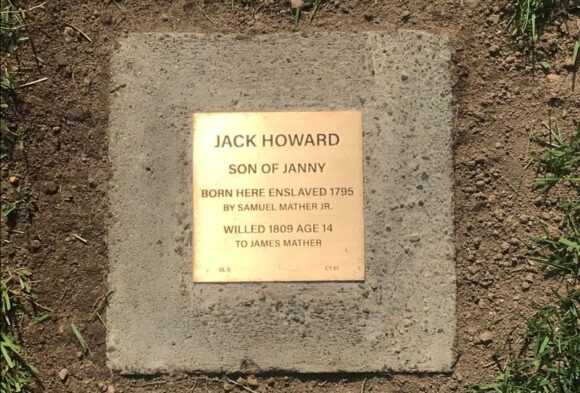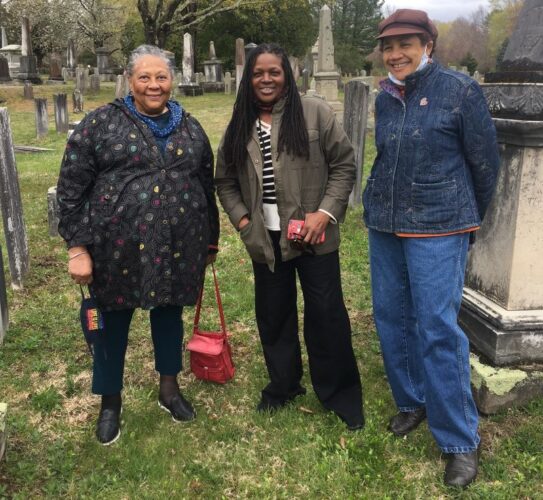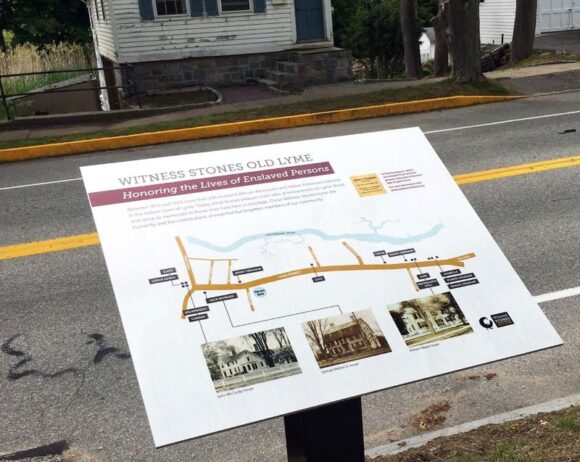
Celebration to Highlight Installation of Plaques Marking Sites of Enslavement in Old Lyme
OLD LYME – The Old Lyme Witness Stones Partnership will hold an installation ceremony Friday, June 4, from 10 to 11:15 a.m. celebrating the town’s newly installed Witness Stones—historical plaques commemorating the lives of 14 individuals, who were once enslaved on Lyme Street.
The project expands the understanding of local history and honors the humanity and contributions of those formerly held in bondage.
Members of the Old Lyme community will gather tomorrow on the lawn of the Old Lyme Phoebe Griffin Noyes Library to honor these people, who collectively represent just some of the individuals once enslaved along today’s Lyme Street:
- Cato
- Lewis Lewia
- Humphrey
- Caeser
- Jack Howard
- Jenny Freeman
- Luce
- Crusa
- Nancy Freeman
- Temperance Still
- Jane
- Pompey Freeman
- Samuel Freeman
- Arabella.
The program will include music, poetry, and words from community partners. World-renowned soprano Lisa Williamson will sing the spiritual, Deep River and the hymn, Amazing Grace.
Twelve members of the Old Lyme Middle School chorus, led by Laura Ventres, will also contribute to the program.
Distinguished Connecticut poets Antoinette Brim-Bell, Marilyn Nelson, and Rhonda Ward will read new works that capture the unheard voices of those enslaved in Lyme.

These poems, by Antoinette Brim-Bell, Marilyn Nelson, Kate Rushin, and Rhonda Ward and created with support from a Health Improvement Collaborative of Southeastern Connecticut (HIC) Partnership Grant for Racial Equity, bring vividly to life experiences, attitudes, and emotions long ignored and then forgotten.
Seventh-grade students from the Lyme-Old Lyme Middle School will read biographical poems they wrote to tell the life stories of Jenny Freeman and Lewis Lewia. Using primary documents, the students researched these two enslaved town residents, making the story of local slavery tangible, personal, and relevant to their own lives.
Lyme-Old Lyme (LOL) Schools Director of Curriculum Michelle Dean commented, “The collective level of engagement and discovery of the students on this project is something you don’t get to see that often. They have done a wonderful job.”
Meanwhile, LOL Schools Social Studies teacher Health Saia, noted, “It has been thrilling seeing the a-ha moments the students are having as they go through the primary documents and meet Jenny Freeman and Lewis Lewia.”
Olivia Hersant, a LOL Schools Language Arts teacher, added, “It’s been exciting. The students are learning and thinking deeply about topics that we didn’t learn about until we were adults.”
Each Witness Stone on Lyme Street includes the name of an enslaved individual, along with important details about their lives and circumstances derived from land records, emancipation certificates, and other available historical documents.

The small brass plaques, embedded flush with the ground, have been placed primarily on the west side of the street for pedestrian safety.

An interpretive sign, pictured above, has also been installed on the lawn of the Old Lyme Phoebe Griffin Noyes Library providing a map of the Lyme Street enslavement sites.
The Old Lyme Witness Stones Partnership’s goal is to expand the understanding of local history and honor the humanity and the contributions of those formerly enslaved in the community.
The partnership’s founding members include the Phoebe Griffin Noyes Library, the Florence Griswold Museum, the Lyme-Old Lyme Schools, and the First Congregational Church of Old Lyme.
Community partners include the Roger Tory Peterson Estuary Center, St. Ann’s Episcopal Church, Lymes’ Youth Service Bureau, and the Old Lyme Historical Society.
Thank you very much.
I deeply honor the many people who contributed their work to our understanding of this aspect of local history, and am very glad to know it. I am so glad to have a fuller image of the people who created this place.
I hope other towns follow Old Lyme’s model. I trace genealogical paths and although Connecticut did not have the enslaved population of other states – these people were here, living and working and some did amazing things. Primus Babcock, for example, was freed following serving in the revolutionary war and went on to own the first paint mixing store in Hartford.